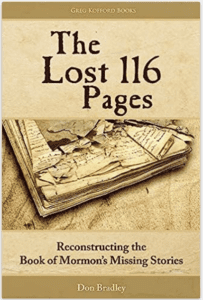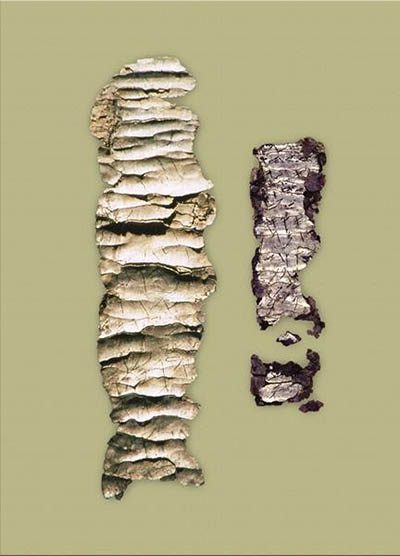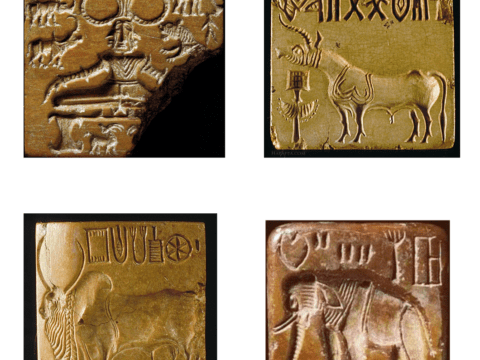 Don Bradley’s new book, The Lost 116 Pages: Reconstructing the Book of Mormon’s Missing Stories (Draper, UT: Greg Kofford Books, 2019), is something I’ve been looking forward to for many months. Even before I finished reading it, I purchased several copies as Christmas gifts. The moment I finished reading Bradley’s riveting final chapter that summarizes what he learned about the Book of Mormon in his exploration of the lost manuscript and the role that played in bringing him back to the Church, I was so impressed that I sent a Kindle edition to another family member that I felt would also love and gain much from this work.
Don Bradley’s new book, The Lost 116 Pages: Reconstructing the Book of Mormon’s Missing Stories (Draper, UT: Greg Kofford Books, 2019), is something I’ve been looking forward to for many months. Even before I finished reading it, I purchased several copies as Christmas gifts. The moment I finished reading Bradley’s riveting final chapter that summarizes what he learned about the Book of Mormon in his exploration of the lost manuscript and the role that played in bringing him back to the Church, I was so impressed that I sent a Kindle edition to another family member that I felt would also love and gain much from this work.
Bradley’s has done outstanding research and draws out many subtle details from the existing Book of Mormon text coupled with numerous finds in other documents that shed light on what may have been in or almost certainly was in the lost manuscript.
To get a feel for the quality of Bradley’s work, one of his 15 chapters has been provided as a stand-alone article at The Interpreter. See Don Bradley, “A Passover Setting for Lehi’s Exodus,” Interpreter: A Journal of Latter-day Saint Faith and Scholarship, 34 (2020): 119-142. I can’t think of a better way to prepare for studying the Book of Mormon in 2020 than by reading this article today (and then buying the book ASAP).
In Bradley’s volume, you’ll learn to appreciate the Book of Mormon in several new ways, and also understand the significance of Joseph’s trauma over the loss. One of the surprising discoveries in reading Bradley’s thoughtful analysis was learning that based on several independent approaches for estimating the size of the lost manuscript, it is clear that it was actually much larger than 116 pages, greatly amplifying the pain of the lost work. The 116 number appears to have been a placeholder based on how many pages were occupied by the translation of the final material from the small plates of Nephi, and not an actual count of the original lost pages. Bradley’s treatment of this issue from several angles is one of several big “ahah!” moments in this book.
You will also learn just how remarkably Jewish the Book of Mormon is. It is not all like the caricature described by our critics of a crude attempt to import the New Testament and modern Christianity into New World. What we learn from the clues we have about the lost manuscript greatly rounds out our appreciation of the Book of Mormon as a book that integrates the New and Old Testament and shows how the message of the Bible expands across hemispheres. As Bradley writes in his “Conclusion”:
One of the most striking and startling things about both the coming forth and the content of the Book of Mormon’s lost text is how Hebraic, and even specifically Jewish, they were. In the buildup to the lost manuscript’s translation, the watershed events in its coming forth were keyed to Jewish festival days (Chapters 1-3). The narrative history within the book itself appears to have begun with one of those feasts (Chapter 7). It also began at the opening of the great shaping condition of Jewish life across millennia: the Diaspora, the dispersion of Jews—whose very name means people of Judea—across a wider world. Although it appears to have largely escaped note, the Book of Mormon tells us that it began in the literal very first days of the Diaspora (Chapters 6-7). The lives of Lehi and Nephi were consequently devoted to solving, in part, the problem of Diaspora or Exile: if they could not remain perpetually in Judea could they create their own Judea and restore the wholeness of the original Jewish commonwealth that had existed there? The problem Lehi and Nephi sought to solve was thus a distinctively Jewish problem.
There is an academic idea that during the Book of Mormon’s coming forth the Restoration was very Christian primitivist—focused selectively on the New Testament and restoring the primitive church like many movements around Joseph Smith at the time (such as the Stone-Campbell movement from which Sidney Rigdon emerged). When we look at the earliest part of the Book of Mormon—the first half of Mormon’s abridgment that was lost—we do indeed find a restorationist program being enacted by Lehi and Nephi; but rather than trying to build the New Testament church, they were trying to rebuild “Old Testament” Israel! The contents of the lost pages thus entirely buck scholarly expectation that the Book of Mormon will behave as a New Testament-focused, nineteenth-century Christian primitivist text.
One of the great benefits of Bradley’s work is the detective work to determine what might have been on the lost manuscript. There are extensive clues, such as details Mormon treats as if they will be well known to the reader but are not, or important story elements that seem like they should be there but are missing. In noting these elements and seeking to understand what we can, Bradley often illustrates the benefits of a deep reading of the text and time after time illustrates the integrity of the complete Book of Mormon text. Often such analysis shows there is more than meets the eye in the Book of Mormon.
One minor example is the kingship of King Mosiah1. A little detail that some might see as a contradiction or an oversight by Joseph Smith as fabricator is the failure of Mosiah1 to bear the name supposedly given to all Nephite Kings, Nephi. Bradley plausibly argues that the Nephite dynasty was overthrown, and that a new person not of the royal lineage became king. Indeed, the text tells us that Mosiah1 “was made king” (Omni 1:12), suggesting that he was not the natural, rightful successor. This happened when the majority of Nephites were destroyed, and Mosiah1 as prophet led away the few that would believe him in a second Nephite Exodus. The details of what happened are missing, but we read of prophecy and fulfillment for something dramatic, and the result is a new line of kings.
When I first heard of this book, I wondered what could possibly justify a whole book on a manuscript we don’t have, but Don Bradley has truly surprised me with some of the most important information I’ve encountered about the Book of Mormon. This book does much more than simply pull together and analyze many clues about the contents and nature of the lost manuscript. It helps us see the unity, the antiquity, and the Jewishness of the intended complete text, along with its persistent focus on the Messiah, the deliverance provided by the Messiah, and the sacred temple. He gives us valuable new ways of understanding the surviving text and the intent of Mormon in compiling it.
Bradley’s detailed scholarship and clever sleuthing helps bring many new threads of evidence together that most of us never suspected were there. Years of digging and analyzing have gone into this. Until some or all of the lost pages were found, this work helps fill in some gaps and solves a number of puzzles that will help both typical readers and future scholars in seeing the text in new ways. But I”m still hoping to see the joyous day, if possible, when all or even a tiny portion of the missing manuscript will be found.
Flaws? Not many. Sometimes Bradley may seem too speculative on some possibilities where the evidence is murky. Other times some passages could be more compact. But his style is highly engaging and readable and I feel will sustain reader interest throughout. In addition to stimulating reader interest and respect for the Book of Mormon, I believe this work will also stimulate new scholarship as his ideas and proposals are refined or further tested and revised, as needed.
Overall, this is a remarkable breakthrough and a valuable resource for any student of the Book of Mormon. It is a wonderful albeit sometimes tentative tool for a more intelligent approach to the incredible text, both the intended text and the text that we now have.












I see you've quickly changed the subject from the church's hoarding of wealth and negligence to be charitable with the tithes they store up and invest and withhold.
Wait, you mean once I address a topic I have to stick to that forever, less some anonymous critic accuse me of changing the topic? Man, all the secret rules nobody told me before I started blogging. I confess, this is a new topic! And actually, your comment is off topic.
This comment has been removed by a blog administrator.
Anonymous, I hope your protests are providing you with some fantastic catharsis.
In the meantime, Jeff, good review. My Christmas hints to my family regarding this book definitely did not work so I'll just have to get it myself. I'm sure the insights will be well worth it and I can't wait for the Book of Mormon Come, Follow Me material.
Catharsis, Hoosier? Nothing repressed. No conflict to resolve.
I just enjoy watching the apologists squirm when we have the occasional opportunity to see what the moral quality of their church actually is.
Jeff, I wouldn't get too excited about hundreds of pages. Bradley is overreaching, speculating to increase the magnitude of the loss, which was significant. His timelines are problematic on when Oliver started copying O. He probably wasn't up to 116 pages in his copying by the time the 1830 preface was typeset in late August (which has the number 116), so Bradley is just speculating that he got the 116 figure from the length of P, in order to say it isn't a reliable, accurate number and to be able to inflate the length of the lost MS.
This was lovely to readd